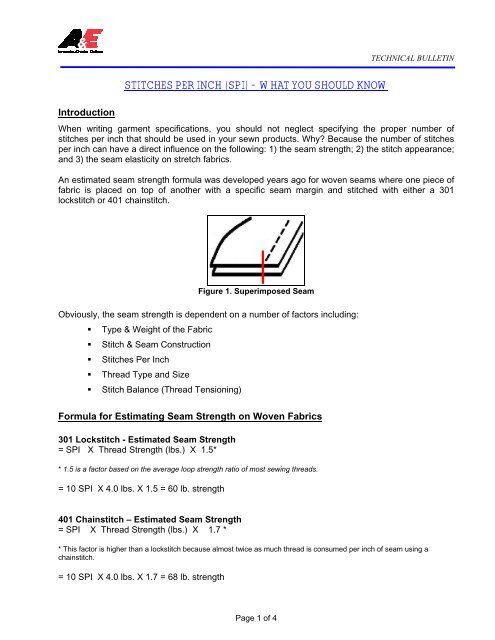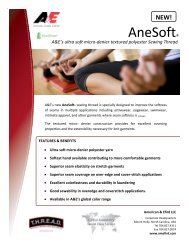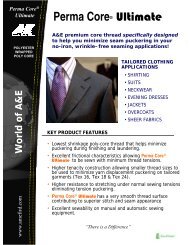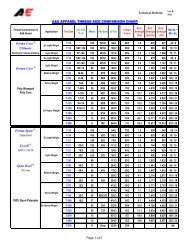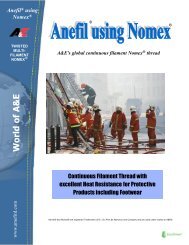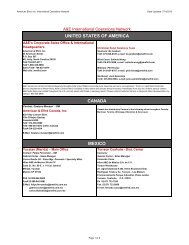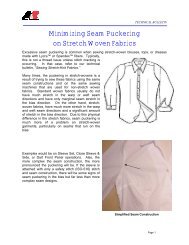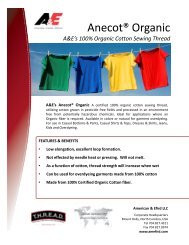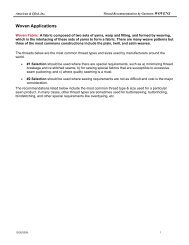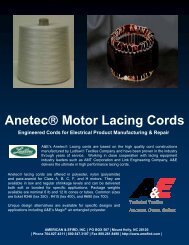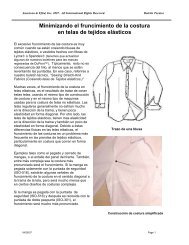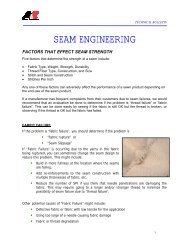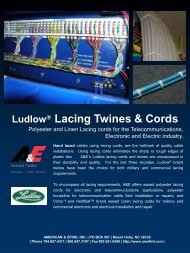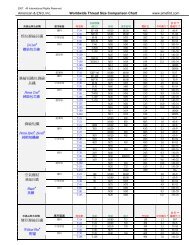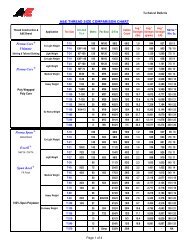STITCHES PER INCH (SPI) - WHAT YOU SHOULD KNOW
STITCHES PER INCH (SPI) - WHAT YOU SHOULD KNOW
STITCHES PER INCH (SPI) - WHAT YOU SHOULD KNOW
Create successful ePaper yourself
Turn your PDF publications into a flip-book with our unique Google optimized e-Paper software.
Introduction<strong>STITCHES</strong> <strong>PER</strong> <strong>INCH</strong> (<strong>SPI</strong>) - <strong>WHAT</strong> <strong>YOU</strong> <strong>SHOULD</strong> <strong>KNOW</strong>TECHNICAL BULLETINWhen writing garment specifications, you should not neglect specifying the proper number ofstitches per inch that should be used in your sewn products. Why? Because the number of stitchesper inch can have a direct influence on the following: 1) the seam strength; 2) the stitch appearance;and 3) the seam elasticity on stretch fabrics.An estimated seam strength formula was developed years ago for woven seams where one piece offabric is placed on top of another with a specific seam margin and stitched with either a 301lockstitch or 401 chainstitch.Figure 1. Superimposed SeamObviously, the seam strength is dependent on a number of factors including:• Type & Weight of the Fabric• Stitch & Seam Construction• Stitches Per Inch• Thread Type and Size• Stitch Balance (Thread Tensioning)Formula for Estimating Seam Strength on Woven Fabrics301 Lockstitch - Estimated Seam Strength= <strong>SPI</strong> X Thread Strength (lbs.) X 1.5** 1.5 is a factor based on the average loop strength ratio of most sewing threads.= 10 <strong>SPI</strong> X 4.0 lbs. X 1.5 = 60 lb. strength401 Chainstitch – Estimated Seam Strength= <strong>SPI</strong> X Thread Strength (lbs.) X 1.7 ** This factor is higher than a lockstitch because almost twice as much thread is consumed per inch of seam using achainstitch.= 10 <strong>SPI</strong> X 4.0 lbs. X 1.7 = 68 lb. strengthPage 1 of 4
TECHNICAL BULLETINFrom this formula, you can see the impact that stitches per inch, thread strength and stitch selectionhave on the strength of the seam. Generally, the more stitches per inch, the greater the seamstrength. There are rare cases where adding stitches per inch can actually damage the fabric so thatthe seam is weakened, however, this only happens on specific fabrics that can be damaged byexcessive needle penetrations.Given:- 301 Lockstitch Superimposed Seam- Thread Used Top & Bottom = T-24 Perma Core – Strength: 2.6 lbs.Estimated SeamStrength<strong>SPI</strong> 6 8 10 1223.4 lbs. 31.2 lbs. 39 lbs. 46.8 lbs.As you can see from the chart above, the stitches per inch has a tremendous impact on the strengthof the seam, as long as the fabric doesn’t rupture before the thread. If the same seams were sewnwith a lower tenacity spun polyester thread, this also will effect the resulting seam strength.Given:- 301 Lockstitch Superimposed Seam- Thread Used Top & Bottom = T-27 Spun Poly – Strength: 2.2 lbs.Estimated SeamStrength<strong>SPI</strong> 6 8 10 1220 lbs. 26 lbs. 33 lbs. 40 lbs.Some manufacturers substitute a smaller bobbin thread when sewing lockstitch seams to minimizethe number of times it takes the sewing operator to change the bobbin. Remember, however, thatthe resulting seam strength will be much less and will be determined by the strength of the bobbinthread and not the needle thread.How to Measure the Stitch Length or Stitches Per Inch?The stitch length is measured by measuring the number of lengths of thread found within one inch.Stitch counters are available from A&E that make this measurement easier, however, you can placea ruler next to the seam and perform the same task.Figure 2. Stitch Counter Measuring <strong>SPI</strong><strong>SPI</strong> is measured by counting the number of lengths ofthread found within one inch. As you can see here,there are approximately 9 <strong>SPI</strong> sewn in this seam.Page 2 of 4
TECHNICAL BULLETIN<strong>SPI</strong> Recommendations for Wovens & KnitsBelow is a list of garments and the typical number of Stitches Per Inch recommended for each ofthem.WOVEN GARMENTSGarments <strong>SPI</strong> Comments Garments <strong>SPI</strong> CommentsDenim Jeans,Jackets, Skirts 7 – 8Twill Pants orShorts 8 – 10Fewer stitches per inchgenerally will give a morecontrast stitchappearance.Childrenswear8 - 10More stitches per inchwill help minimize seamgrinning. Dresses, Skirts 10 - 12Usually 8 to 10 spi isadequate to provideadequate seam strengthand at the same timeallow for quicker cycletimes .Due to many of theoperations beinglockstitch, usually 10 –12 spi is required toprovide adequate seamstrength.Trousers,Dress Pants,Slacks10 - 12On some operations likeserge panels, it may bedesirable to use a longerstitch length.BlindstitchOperations onSlacks, Dresses,Skirts, etc.3 – 5A long stitch length isdesirable to minimizethe dimple orappearance of theneedle penetration onthe outside of thegarment.Dress Shirt orBlouse 14 – 20Using more <strong>SPI</strong> allowsthe use of smallerdiameter threads that willminimize seampuckering.Buttonsew(4 hole button)16Buttonsew machinesare cycle machines witha predeterminednumber of stitches percycle.Casual Shirts,Blouses, Tops 10 - 14Using more <strong>SPI</strong> will givemore of a tailored stitchappearance and betterseam coverage whenserging.Buttonhole(1/2” purl orwhip stitch)85 - 90Generally sewnvertically – approx. 85-90 stitches with alockstitch buttonholemachine.When setting standards for stitches per inch, you should always keep in mind that more stitches perinch used in a seam requires longer sewing cycles to complete the seam. Longer sewing cyclestranslates in to higher labor costs and lower production levels. A sewing machine sewing at 5,000SPM (stitches per minute) at 8 <strong>SPI</strong> will sew 17.4 yards of seam per minute. A sewing machinesewing at 5,000 SPM at 14 <strong>SPI</strong> will sew 9.9 yards of seam per minute.More stitches per inch will also consume for thread per inch of seam. This will contribute to higherseam strength and more elastic seams, but will also increase the consumption of thread required tosew the garment.Page 3 of 4
TECHNICAL BULLETINTherefore, the recommendations listed above are common stitch levels that provide adequate seamstrength but also take into consideration the factors just mentioned.When sewing knit fabrics, you should always check for excessive “seam grinning” of the seam; andalso check for “stitch cracking”. “Seam grinning” occurs when thread stitch balance is too looseallowing the seam to open up too much when stress is applied to it. “Stitch Cracking” is checked byapplying pressure on the seam in the stitching direction. If the thread tensions are too tight or if youare not using enough stitches per inch, the threads will rupture as stress is applied on the seam.Therefore, the following recommendations have been made for the number of stitches per inch to beused on the following garments.KNIT GARMENTSGarments <strong>SPI</strong> Comments Garments <strong>SPI</strong> CommentsJersey T-Shirts,Tops, PolosUnderwear10 - 1212 – 14Infantwear 10 - 12Using more <strong>SPI</strong>increases the chance ofneedle cutting.The more elastic theseam, the more <strong>SPI</strong> thatshould be used tominimize stitch cracking.The more elastic theseam, the more <strong>SPI</strong> thatshould be used tominimize stitch cracking.Swimwear 12 - 16Dresses, SkirtsIntimates10 - 1212 – 16The more elastic theseam, the more <strong>SPI</strong> thatshould be used tominimize stitchcracking.The more elastic theseam, the more <strong>SPI</strong> thatshould be used tominimize stitchcracking.The more elastic theseam, the more <strong>SPI</strong> thatshould be used tominimize stitchcracking.Fleece10 – 12More stitches per inchare required to providethe proper seamcoverage on fleece.Stretch Knits(Lycra®,Spandex®, etc.)14 - 18More stitches per inchare required to providethe proper seamelasticity.Sweaters (Med.To Hvy.)8 - 10The more elastic theseam, the more <strong>SPI</strong> thatshould be used tominimize stitch cracking.Hosiery, Socks35 – 50Usually sewn with veryfine thread. More spiare required to minimizeseam grinning andseam elasticity.SummaryFrom the comments and information listed above, you can see how important adding specificationsfor Stitches Per Inch to your garment specification instructions. Using the correct number of stitchesper inch can greatly enhance the strength, appearance and performance of the seam for a givenfabric type and application. If you need assistance in determining what would be an adequate stitchlevel for your sewn products, please contact A&E’s technical service team for assistance. We lookforward to serving you.Page 4 of 4


